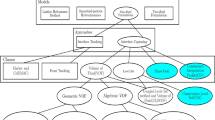Abstract
A key ingredient in simulation of flow in porous media is accurate determination of the velocities that drive the flow. Large‐scale irregularities of the geology (faults, fractures, and layers) suggest the use of irregular grids in simulation. This paper presents a control‐volume mixed finite element method that provides a simple, systematic, easily implemented procedure for obtaining accurate velocity approximations on irregular (i.e., distorted logically rectangular) block‐centered quadrilateral grids. The control‐volume formulation of Darcy’s law can be viewed as a discretization into element‐sized “tanks” with imposed pressures at the ends, giving a local discrete Darcy law analogous to the block‐by‐block conservation in the usual mixed discretization of the mass‐conservation equation. Numerical results in two dimensions show second‐order convergence in the velocity, even with discontinuous anisotropic permeability on an irregular grid. The method extends readily to three dimensions.
Similar content being viewed by others
References
I. Aavatsmark, T. Barkve, Ø. Bøe and T. Mannseth, Discretization on non-orthogonal, quadrilateral grids for inhomogeneous, anisotropic media, J. Comput. Phys., submitted.
I. Aavatsmark, T. Barkve, Ø. Bøe and T. Mannseth, Discretization on unstructured grids for inhomogeneous, anisotropic media, Part I: Derivation of the methods, SIAM J. Sci. Comput., submitted.
T. Arbogast, P. Keenan, M. Wheeler and I. Yotov, Logically rectangular mixed methods for Darcy flow on general geometry, in: Proceedings of the 13th SPE Symposium on Reservoir Simulation (Society of Petroleum Engineers, Dallas, 1995) pp. 51–59.
T. Arbogast, M.F. Wheeler and I. Yotov, Mixed finite elements for elliptic problems with tensor coefficients as cell-centered finite differences, SIAM J. Numer. Anal. 34 (1997) 828–852.
B.R. Baliga and S.V. Patankar, A new finite-element formulation for convection-diffusion problems, Numer. Heat Transfer 3 (1980) 393–409.
R.E. Bank and D.J. Rose, Some error estimates for the box method, SIAM J. Numer. Anal. 24 (1987) 777–787.
F. Brezzi and M. Fortin, Mixed and Hybrid Finite Element Methods, Springer Series in Computational Mathematics 15 (Springer, Berlin, 1991).
Z. Cai, J. Mandel and S.F. McCormick, The finite volume element method for diffusion equations on general triangulations, SIAM J. Numer. Anal. 28 (1991) 392–402.
C. Duncan and J. Jones, A mixed method Poisson solver for three-dimensional self-gravitating astrophysical fluid dynamical systems, in: 6th Copper Mountain Conference on Multigrid Methods, Vol. CP 3224, eds. N.D. Melson, T.A. Manteuffel and S.F. McCormick(NASA, Hampton, VA, 1993) pp. 159–173.
R.E. Ewing and R.F. Heinemann, Incorporation of mixed finite element methods in compositional simulation for reduction of numerical dispersion, in: Proceedings of the 7th SPE Symposium on Reservoir Simulation (Society of Petroleum Engineers, Dallas, 1983) pp. 341–347.
R.E. Ewing, T.F. Russell and M.F. Wheeler, Simulation of miscible displacement using mixed methods and a modified method of characteristics, in: Proceedings of the 7th SPE Symposium on Reservoir Simulation (Society of Petroleum Engineers, Dallas, 1983) pp. 71–81.
C.L. Farmer, D.E. Heath and D.O. Moody, A global optimization approach to grid generation, in: Proceedings of the 11th SPE Symposium on Reservoir Simulation (Society of Petroleum Engineers, Dallas, 1991).
P.A. Forsyth, A control volume finite element method for local mesh refinement, in: Proceedings of the 10th SPE Symposium on Reservoir Simulation (Society of Petroleum Engineers, Dallas, 1989) pp. 85–96.
Z. E. Heinemann, C. Brand, M. Munka and Y.M. Chen, Modeling reservoir geometry with irregular grids, in: Proceedings of the 10th SPE Symposium on Reservoir Simulation (Society of Petroleum Engineers, Dallas, 1989) pp. 37–54.
J. Douglas, Jr., R.E. Ewing and M.F. Wheeler, Approximation of the pressure by a mixed method in the simulation of miscible displacement, RAIRO Anal. Numér. 17 (1983) 17–33.
J.E. Jones, A mixed finite volume element method for accurate computation of fluid velocities in porous media, Ph.D. thesis, University of Colorado at Denver (1995).
C. Liu and S.F. McCormick, The finite volume element method (FVE) for planar cavity flow, in: Proceedings of the 11th International Conference on CFD, Williamsburg, VA (1988).
D.K. Ponting, Corner point geometry in reservoir simulation, in: The Mathematics of Oil Recovery, ed. P.R. King (Clarendon Press, Oxford, 1992) pp. 45–65.
P.A. Raviart and J.M. Thomas, A mixed finite element method for 2nd order elliptic problems, in: Mathematical Aspects of Finite Element Methods, eds. I. Galligani and E. Magenes (Springer, Berlin, 1977) pp. 292–315.
B. Rozon, A generalized finite volume discretization method for reservoir simulation, in: Proceedings of the 10th SPE Symposium on Reservoir Simulation (Society of Petroleum Engineers, Dallas, 1989) pp. 71–84.
T.F. Russell, Rigorous block-centered discretizations on irregular grids: Improved simulation of complex reservoir systems, Technical Report No. 3, Project Report, Reservoir Simulation Research Corporation (1995).
J. Shen, Mixed finite element methods on distorted rectangular grids. Technical Report, Institute for Scientific Computation, Texas A&M University (1994).
J.M. Thomas, Sur l'analyse numérique des méthodes d'éléments finis hybrides et mixtes, Ph.D. thesis, Université Pierre et Marie Curie (1977).
J.M. Thomas and D. Trujillo, Analysis of finite volume methods, in: Mathematical Modelling of Flow Through Porous Media, eds. A.P. Bourgeat, C. Carasso, S. Luckhaus and A. Mikelić (World Scientific, Singapore, 1995) pp. 318–336.
J. Wang and T. Mathew, Mixed finite element methods over quadrilaterals, in: Advances in Numerical Methods & Applications (Sofia, 1994) pp. 203–214.
Author information
Authors and Affiliations
Rights and permissions
About this article
Cite this article
Cai, Z., Jones, J., McCormick, S. et al. Control‐volume mixed finite element methods. Computational Geosciences 1, 289–315 (1997). https://doi.org/10.1023/A:1011577530905
Issue Date:
DOI: https://doi.org/10.1023/A:1011577530905




